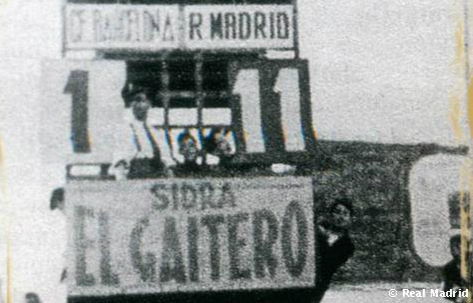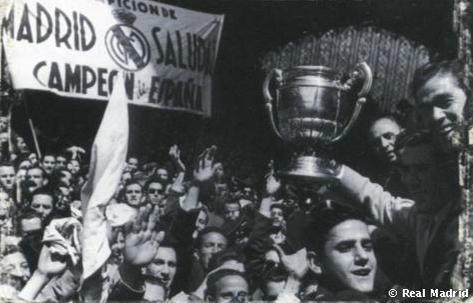

Santiago Bernabéu’s arrival as President went hand in hand with the creation of a legendary team and a universal Club. A few months before the President took office, Real Madrid defeated Barcelona in the Cup of Spain 11-1. Bernabéu always looked to the future and envisioned a new stadium at Chamartín capable of holding a crowd of 75,000. This was the first challenge of this unique man.





THE CLUB RECOVERS ITS CROWN
On 1 January 1941, after recovering their crown, Madrid Football Club changed their name to Real Madrid Club de Fútbol.
HISTORICAL VICTORY AGAINST BARCELONA: 11-1
In the second leg of the semifinals of the Cup of Spain of 1943, Real Madrid earned an historical victory over Barcelona, defeating the Catalans 11-1. The Whites were bitter about the 3-0 defeat at Las Corts Stadium in the first leg and the bad reception Barcelona’s fans gave them. They stepped onto the pitch at Chamartín Stadium determined to earn a victory and sealed a spectacular 8-0 score at the end of the first half. At the end of the match, the score-board reflected an historical figure: 11-1. Pruden (4), Barinaga (3), “Chus” Alonso (2), Alsúa and Botella scored Real Madrid’s eleven strikes, while Martín tallied Barcelona’s only goal.
BERNABÉU'S ERA BEGINS
Antonio Santos Peralba, President of Real Madrid, and the Marquis Mesa de Asta, President of Barcelona, were forced out of their jobs by the hostilities between both teams during the semifinals. In gatherings attended by outstanding figures at Real Madrid the name of Santiago Bernabéu, who had no dealings with the Club since 1935, came up. He was easily convinced to become the Club’s next President and his appointment was made public on 15 September 1943. Ernesto Cotorruelo, President of the Football Association of Castilla, presided the Presidency Handover between Peralba and Bernabéu, which was also attended by members of their Boards of Directors.
CHAMARTÍN COST 37 MILLION PESETAS
In spring 1943, Santos Peralba pointed out that a new stadium should be built and that it should hold a crowd of 40,000 people. Less than a year later, Santiago Bernabéu was much more ambitious in one of his Board meetings: “Gentlemen, we need a much larger Stadium and we are going to build it.” Bernabéu decided to build a stadium capable of holding 75,000 people in its first stage and whose building works would amount to 37 million pesetas (222,375 Euro).
BERNABÉU'S FIRST TWO TITLES
The 1940s weren’t the best of decades for Real Madrid, but they marked the start of Bernabéu’s office and the Club’s return to winning titles. The first were two consecutive Cups of Spain won in 1946 and 1947 after defeating Valencia 3-1 and Espanol 2-0, respectively.
PIONEER IN HAVING NUMBERED SHIRTS
On 23 November 1947, in a game against Atletico Madrid at the Metropolitano Stadium, Real Madrid became the first Spanish team to wear numbered shirts. It was Pablo Hernández Coronado’s idea. The Spanish FA liked the initiative an decreed in 1948 that every team should have their players numbered in the range between 2 and 11. Once again, Real Madrid were pioneers in Spanish football.
SPECTACULAR INAUGURATION OF THE NEW CHAMARTÍN STADIUM
The inauguration of the new Chamartín Stadium was very solemn. A mass was held on 14 December 1947, followed by a series of acts paying tribute to Santiago Bernabéu’s vision and to the members whose money had financed the construction. The match between Real Madrid and Os Belenenses kicked-off at 3:30 pm when they were over. Real Madrid defeated the Portuguese side 3-1 and the new Colosseum became the pride of all Madrdismo and the envy of every football Club in Spain.
KUBALA'S FAILED SIGNING
In 1948, Real Madrid underwent a radical renewal of their squad. Two years later, they tried to sign Ladislao Kubala, who had arrived in Spain with his then team Hungaria. Negotiations were called off because the player wanted to include his brother-in-law, Fernando Daucik, as coach in the deal and Bernabéu did not comply.
MOLOWNY, THE ONLY MADRIDISTA IN THE 1950 WORLD CUP
Spain achieved the great feat of getting to the quarterfinals of the Brazil 1950 World Cup and the only Real Madrid player on the squad was Luis Molowny, who stood out above his teammates in their 2-2 draw against Uruguay, who would go on to win the tournament.